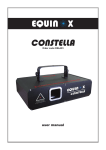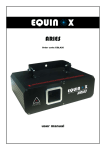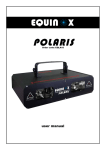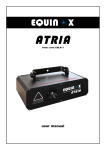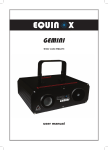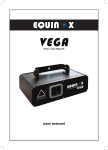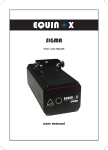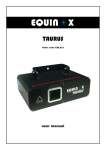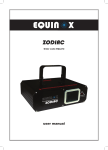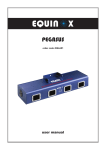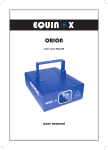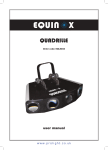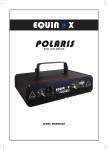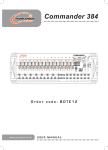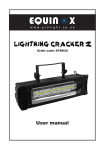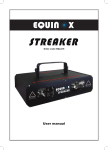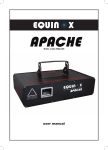Download Instruction manual
Transcript
NEBULA order code: EQLA07 user manual Equinox Nebula Laser Safety WARNING FOR YOUR OWN SAFETY, PLEASE READ THIS USER MANUAL CAREFULLY BEFORE YOUR INITIAL START-UP! CAUTION! Keep this equipment away from rain, moisture and liquids. SAFETY INSTRUCTIONS Every person involved with the installation, operation & maintenance of this equipment should: - Be competent - Follow the instructions of this manual CAUTION! TAKE CARE USING THIS EQUIPMENT! HIGH VOLTAGE-RISK OF ELECTRIC SHOCK!! Before your initial start-up, please make sure that there is no damage caused during transportation. Should there be any, consult your dealer and do not use the equipment. To maintain the equipment in good working condition and to ensure safe operation, it is necessary for the user to follow the safety instructions and warning notes written in this manual. Please note that damages caused by user modifications to this equipment are not subject to warranty. Equinox Nebula Laser Safety IMPORTANT: The manufacturer will not accept liability for any resulting damages caused by the non-observance of this manual or any unauthorised modification to the equipment. • Never let the power-cable come into contact with other cables. Handle the power-cable and all mains voltage connections with particular caution! • Never remove warning or informative labels from the equipment. • Do not open the equipment and do not modify the equipment. • Do not connect this equipment to a dimmer-pack. • Do not switch the equipment on and off in short intervals, as this will reduce the system’s life. • Only use the equipment indoors. • Do not expose to flammable sources, liquids or gases. • Always disconnect the power from the mains when equipment is not in use or before cleaning! Only handle the power-cable by the plug. Never pull out the plug by pulling the power-cable. • Make sure that the available voltage is between 220v/240v. • Make sure that the power-cable is never crimped or damaged. Check the equipment and the power-cable periodically. • If the equipment is dropped or damaged, disconnect the mains power supply immediately. Have a qualified engineer inspect the equipment before operating again. • If the equipment has been exposed to drastic temperature fluctuation (e.g. after transportation), do not switch it on immediately. The arising condensation might damage the equipment. Leave the equipment switched off until it has reached room temperature. • If your product fails to function correctly, discontinue use immediately. Pack the unit securely (preferably in the original packing material), and return it to your Prolight dealer for service. • Only use fuses of same type and rating. • Repairs, servicing and power connection must only be carried out by a qualified technician. THIS UNIT CONTAINS NO USER SERVICEABLE PARTS. • WARRANTY; One year from date of purchase. OPERATING DETERMINATIONS If this equipment is operated in any other way, than those described in this manual, the product may suffer damage and the warranty becomes void. Incorrect operation may lead to danger e.g.: short-circuit, burns, electric shocks, lamp failure etc. Do not endanger your own safety and the safety of others! Incorrect installation or use can cause serious damage to people and property. Equinox Nebula Laser Technical specifications You should find inside the Laser carton the following items: 1, Nebula Laser 2, Power cable 3, A DMX cable 4, Instruction manual Technical Specifications: Voltage: 240V AC 50Hz Laser diode: 1 x 50mW Green (532nm) DPSS laser 1 x 100mW Red (650nm) DPSS laser Operating modes: 1, Stand Alone Sound Activated 2, Stand Alone Auto programme 3, DMX-512 4 channels Function Settings: 1, Stand Alone Sound Activated, set all dipswitches to OFF. Then use the sensitivity control to set the desired activation level. 2, Stand Alone Auto Programme change, set dipswitch 1 to ON, then set all other switches to OFF 3, For DMX operation set dipswitch 10 to ON, then set all other switches to OFF. When used in DMX mode please note: Set Channel 1 to DMX No: 0 to 63 for sound activation mode. Set Channel 1 to DMX No: 64 to 200 for auto programme change mode. Set Channel 1 to DMX No: 201 to 255 to obtain access to channel 2 for rotation, channel 3 for colour and channel 4 for speed of rotation. Set Channel 2 to DMX No: 0 to 4 to blackout the laser. When using long DMX runs or multiple heads. A DMX terminator plug should be used on the last head in the chain. Equinox Nebula Laser DMX Table DMX table: DMX Channel Channel 1 Function Control Mode Channel 2 Channel 3 Channel 4 Flash Direction Speed DMX Number Description 0-63 Sound Activated mode 64-200 Auto programme change 201-255 DMX control mode 0-4 Blackout 5-70 Red and Green flash speed 71-150 Red or Green flash speed 151-200 Red 201-250 Green 251-255 Red & Green 0-9 Stop 10-100 Clockwise direction 101-200 Anti-clockwise direction 201-255 Anti-clockwise and Clockwise direction 0 = Fast, 255 = Slow Back view: Identification: 1, Power input 2, Power switch 3, Cooling fan 4, DMX out 5, Dip switches 6, DMX in 7, Hanging bracket 8, Microphone 9, LED power indicator 10, Volume control 5 Equinox Nebula Laser DMX control mode DMX Control Mode Operating in a DMX control mode environment gives the user the greatest flexibility when it comes to customising or creating a show. In this mode you will be able to control each individual trait of the fixture and each fixture independently. Setting the DMX address The DMX mode enables the use of a universal DMX controller. Each fixture requires a “start address” from 1- 511. A fixture requiring one or more channels for control begins to read the data on the channel indicated by the start address. For example, a fixture that occupies or uses 7 channels of DMX and was addressed to start on DMX channel 100, would read data from channels: 100,101,102,103,104,105 and 106. Choose a start address so that the channels used do not overlap. E.g. the next unit in the chain starts at 107. Set the start address using the group of dip switches located usually on the back of the fixture. Each dipswitch has an associated value. Adding the value of each switch in the ON position will provide the start address. Determining which switches to toggle ON given a specific start address can be accomplished in the following manner. By subtracting the largest switch value possible from the selected start address until zero is achieved. EXAMPLE STARTING ADDRESS Address 10 on Pin NO: 4 = 8 Pin NO: 2 = 2 Total = 10 Address 24 on Pin NO: 5 = 16 Pin NO: 4 = 8 Total = 24 DMX address using simple maths 233 - (128 = 105, Turn on dip No: 8 105 - (64) = 41, Turn on dip No:7 41 - (32) = 9, Turn on dip No: 6 9 - (8) = 1, Turn on dip No: 4 1 - (1) = 0, Turn on dip No:1 You will most likely use the first available number which maybe Number 1. This number was selected for example purposes DIP SWITCH 1 2 3 4 5 6 7 8 9 10 (DMX VALUE) 1 2 4 8 16 32 64 128 256 Equinox Nebula Laser DMX set up DMX-512: • DMX (Digital Multiplex) is a universal protocol used as a form of communication between intelligent fixtures and controllers. A DMX controller sends DMX data instructions form the controller to the fixture. DMX data is sent as serial data that travels from fixture to fixture via the DATA “IN” and DATA “OUT” XLR terminals located on all DMX fixtures (most controllers only have a data “out” terminal). DMX Linking: • DMX is a language allowing all makes and models of different manufactures to be linked together and operate from a single controller, as long as all fixtures and the controller are DMX compliant. To ensure proper DMX data transmission, when using several DMX fixtures try to use the shortest cable path possible. The order in which fixtures are connected in a DMX line does not influence the DMX addressing. For example; a fixture assigned to a DMX address of 1 may be placed anywhere in a DMX line, at the beginning, at the end, or anywhere in the middle. When a fixture is assigned a DMX address of 1, the DMX controller knows to send DATA assigned to address 1 to that unit, no matter where it is located in the DMX chain. DATA Cable (DMX cable) requirements (for DMX operation): • The Equinox laser can be controlled via DMX-512 protocol. The DMX address is set on the back of the unit. Your unit and your DMX controller require a standard 3-pin XLR connector for data input/output (figure 1). Figure 1 Further DMX cables can be purchased from all good sound and lighting suppliers or Prolight dealers. Please quote: CABL10 – 2M CABL11 – 5M CABL12 – 10M Also remember that DMX cable must be daisy chained and cannot be split. Equinox Nebula Laser DMX Set Up Notice: • Be sure to follow figures 2 & 3 when making your own cables. Do not connect the cable’s shield conductor to the ground lug or allow the shield conductor to come in contact with the XLR’s outer casing. Grounding the shield could cause a short circuit and erratic behaviour. Special Note: Line termination: • When longer runs of cable are used, you may need to use a terminator on the last unit to avoid erratic behaviour. Termination reduces signal transmission problems and interferance. it is always advisable to connect a DMX terminal, (resistance 120 Ohm 1/4 W) between pin 2 (DMX-) and pin 3 (DMX+) of the last fixture. Using a cable terminator (part number CABL90) will decrease the possibilities of erratic behaviour. 5-Pin XLR DMX Connectors: • Some manufactures use 5-pin XLR connectors for data transmission in place of 3-pin. 5-Pin XLR fixtures may be implemented in a 3-pin XLR DMX line. When inserting standard 5-pin XLR connectors in to a 3-pin line a cable adaptor must be used. The Chart below details the correct cable conversion. Equinox Nebula Laser DMX Dip Switch Quick Reference Chart Dip Switch Position Dip Switch position DMX Address Dip Switch Reference Chart Equinox Nebula Laser Safety Class 3B Laser Safety Guide Warning Class 3B Lasers have the potential to harm eyesight if viewed directly and can also be harmful at long distances. Any unit that contains a laser diode has to be classified depending upon the light output that someone may be exposed to. All laser products are classed as defined in the Laser Product Safety Standard (BS/EN 60825.1). The classes range from the safest, which is Class 1, through to the most hazardous, which is Class 4. A laser diode that emits more than 5mW of light and less than 500mW can be classified as a Class 3B product. Operation and installation Notes Laser effects should only be installed and operated by persons who have been trained in how to operate laser effects safely. Laser effects should be located in a safe and secure position in the venue, so that once installed it cannot be tampered with by unauthorized users. Before operation the path of the laser beams should be taken into account in respect to how the beams will scan the viewing audience. If direct audience scanning is to be used then the laser energy levels from the effects needs to be calculated. Health If used responsibly and in accordance with the relevant guidance issued by the Health and Safety Executive a laser effect will not present a hazard to those viewing the show as long as the laser beams are projected over the heads of the viewing audience. When laser effects are directed into the audience area it becomes difficult to tell if the effects are causing harm. Class 3B laser beams can be harmful to eyesight if viewed directly The injury that a Class 3B laser can inflict is dependant upon several varients, including the amount of time the laser beam enters the eye for, the intensity of beam and what part of the eye that actually receives the beam. The part of the eye which is most susceptible to receive damage from the beam is the retina. The retina is the part of the eye that receives the light signals that are sent to brain. All light entering the eye gets focused onto the retina. Normal light sources including halogen lamps are not usually harmful to view. Lasers are different in the fact that they can get the beam focused down to a very small point on the retina which can burn holes on the back wall of the eye. There are no pain receptors on the retina and the damage can happen in less time than it takes for a person to blink so the person will be not be aware of any damage taking place. Damage to the retina cannot be repaired and therefore is permanent. Symptoms include severe loss of sight and unnoticeable vision loss. Equinox Nebula Laser Safety Licensing and Laws There are no U.K. “laser laws” or any “laser licenses” that need to be obtained in order to own or operate a laser for lightshow use. Detailed and specific guidance is issued by the Health and Safety Executive in the form of a book called HS(G)95 The Radiation Safety of Lasers Used for Display Purposes. Class 3B Laser Safety Features Class 3B laser products need to be fitted with specific safety features. These features are issued in the British Standard on Laser Product Safety BS/EN 60825-1 and are a needed for the product to meet CE approval. The important warnings are listed below:1) Emissions Indicator 2) Remote Interlock Connector 3) Laser Safety Warning Labels Summary of each Feature Class 3B lasers need to contain three very important Laser Safety Warning Labels; the starburst symbol, aperture label, and the warning/classification label. The starburst is used to indicate that the product is a laser product. The aperture label is located next to the appature to show where the laser emits it’s beam(s). The warning/classification label details the class of the laser product, the maximum output power, and the wavelength(s) (colours) of the laser, along with a ” Laser Radiation – Avoid Exposure To The Beam” warning The Remote Interlock Connector will only allow the laser to function when the two pins are shorted together. For lightshow use it is recommended by HS(G)95 laser safety guidance laser effects can be overridden by a remote Emergency Stop switch. The remote interlock connector provides a convenient way for such a switch to be easily added to the laser system, to provide this control. The emissions indicator is fitted to indicate when the laser is ready to produce a light output. Audience Scanning Audience Scanning is when laser beams are directed at the viewing audience. Because the laser output beam can scan people’s faces it carries a risk that it could cause damage to eyesight, if over exposed to the laser beam. Maximum Permissible Exposure (MPE) The amount of laser light that a person can be exposed to without it causing harm to eyesight is known as the Maximum Permissible Exposure or MPE. These levels are set down by the British Laser Safety Standard BS/EN 60826-1. When people are exposed to laser light output which is above the MPE, it may potentially pose a risk of causing eye damage. Calculating what the MPE and exposure level is for a given laser effect is quite a complicated process and it is dependant on a whole number of factors and conditions. The laser safety standard BS/EN 60825-1 contains the information and data required to calculate these levels. Equinox Nebula Laser Safety Laser Safety Officer The BS/EN60825-1 Laser Safety Standard recommends that all venues that use, or businesses that work with Class 3B laser products, should appoint a Laser Safety Officer (LSO). The Laser Safety Officer should be aware of the many safety issues when using lasers, and will also be responsible for overseeing how the laser is used. In smaller businesses, the (LSO) could be the installer, operator or owner etc. Separation Distances Health and Safety guidance details that for supervised installations of lasers which are above the Maximum Permissible Exposure (MPE) should not be accessible to persons in the audience. Also recommended is an area where the MPE may not be exceeded and extends from 3m above to 2.5m laterally from any point in the venue where the public may have access during the lightshow. The illustrations below show the separation distances. Separation Distance Drawing: Note. The 3 metre height specified is not the height of the actual laser unit, but it refers to the height of the laser beams emitted. Equinox Nebula Laser Safety Hazard Distances All lasers for display porposes feature a characteristic called the hazard distance for direct viewing (NOHD). The (NOHD) is distance at which viewing the laser directly is no longer considered a hazard. Note at any point between the laser unit and the calculated hazard distance, it may be hazardous to directly view the laser beams. Exposing the eye to the laser directly from outside the hazard distance is considered to be no longer a risk. The most dangerous senerio is to look directly at a static single beam, because all the light energy is concentrated into one small point. The hazard distances for various different powers of Class 3B laser are shown in the table below. Laser Output Power 10mW 30mW 50mW 100mW 250mW 450mW Hazard Distance 12m 20m 25m 36m 56m 76m Note - The above values in the table have been calculated assuming the characteristics of a typical laser, which has a beam spread of 2mradians. Not all laser units have the same specification. Remember: Static laser beams are hazardous for long distances so it is recommended that the laser beams are projected overhead and not into the viewing audience Laser Safety Books The Radiation Safety of Display Laser Installations HS(G)95 Published by HSE Books 1996 ISBN 0 7176 0691 Health & Safety Executive Website - www.hse.gov.uk Laser display safety guidance page - www.hse.gov.uk/pubns/INDG224.htm Health Protection Agency Website - www.hpa.org.uk













